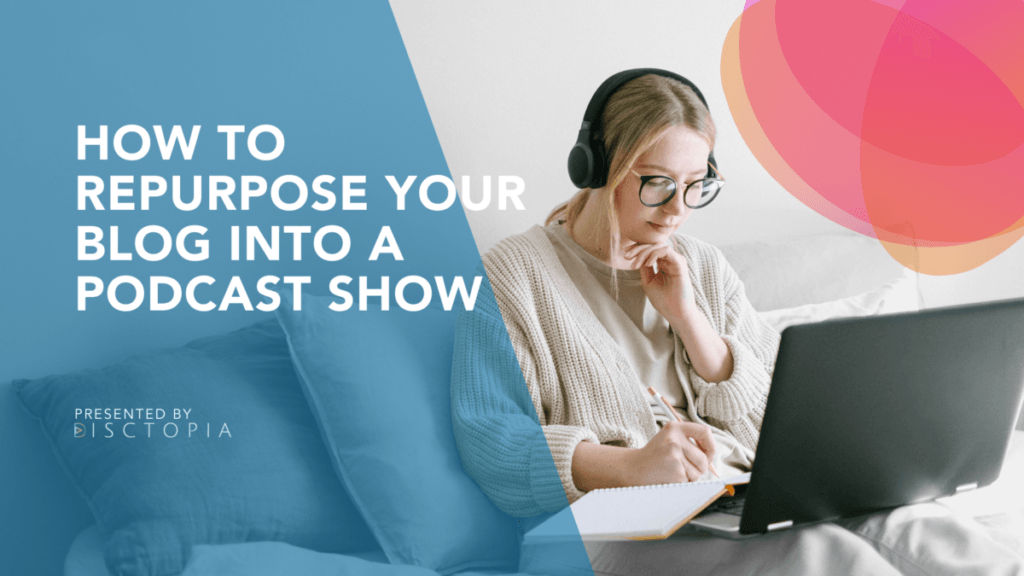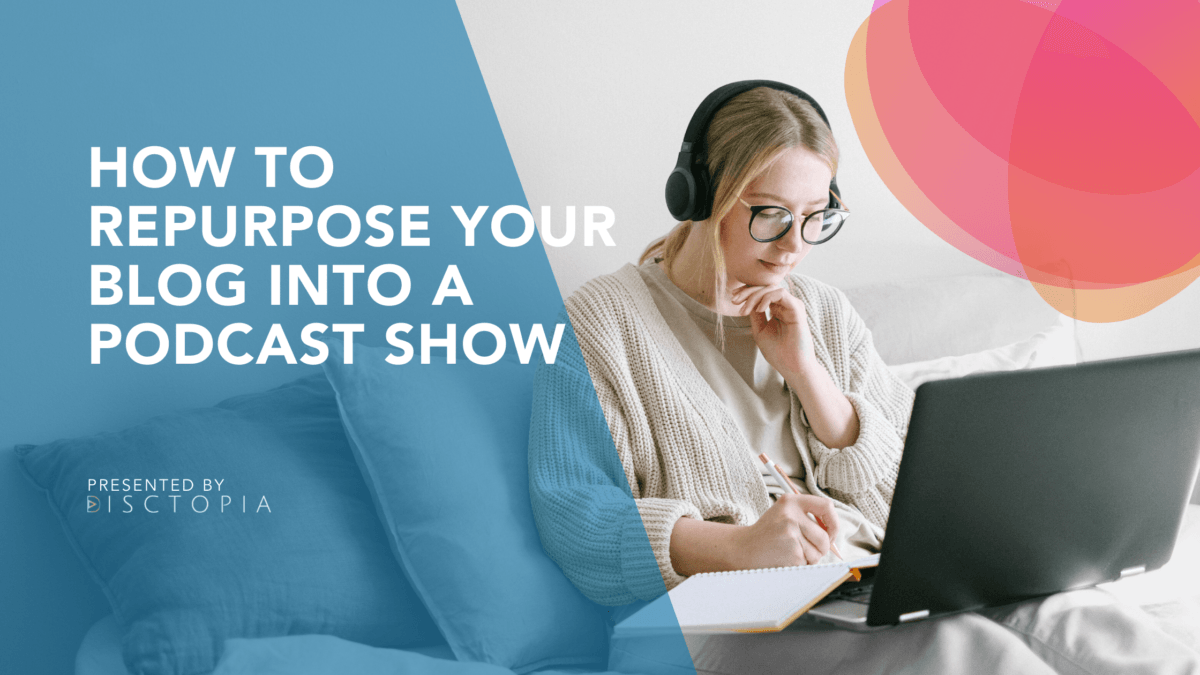
If you're interested in shaking up your content marketing strategy, you need to know how to repurpose your blog into a podcast show. Currently, podcasting is in vogue, and people can't get enough of it.
As a blogger, you can select a couple of your best-performing blog posts and repurpose them into a podcast. Podcasting can be quite fun and rewarding if you are appropriately guided and know what you are doing. Not only that, podcasting can boost your SEO and enhance your brand's engagement. You are about to tap into multiple traffic sources for your brand, from your blog and podcast show.
In the last decade, the number of people who listen to podcasts has doubled. However, there are only 2 million podcasts in the world. With over
600 million blogs on the internet and over 6 million blog posts hitting the web daily, it can be said that the blogging sphere is overcrowded. What's more, unlike blogs, people can listen to podcasts while driving or doing other tasks. In other words, podcasting allows you to reach a new audience.
Now that you are sold on podcasting, you should be interested in how to start a podcast show as a blogger. You will not start from scratch; you'll convert your existing blog content into podcast episodes.
This article will explore how to start a podcast and how to repurpose your blog into a podcast show. Yes.
Repurposing your podcast into a blog is one thing, but converting your blog into audio files is a new experience. So, how do you go about it?
Don't be too quick to convert your blog into a podcast show that you forget to plan thoroughly. You can choose to podcast in a particular genre, where you will only need some of your blog posts. Your blog post will be a foundation for creating a series of podcast episodes. From there, you can structure your show the way you want.
During the planning stage, you determine the type of podcast you want to create. You can choose whether you want your podcast to follow an interview/conversational format, a story-telling approach, or a roundtable podcast type. Both the interview and roundtable podcast approaches require you to invite guests or hire a cohost. All these must be addressed at the planning stage.
-
Gather Your Best Blog Posts
After ascertaining your course of action, you must choose which article will eventually become a podcast. No matter how partial you are to a particular blog post, don't convert it to a podcast based on your personal preferences alone. Your audience should be left, right, and centre in the blog posts you choose.
Your best blog posts are the ones with the highest rate of engagement. This can also be determined by the traffic, impression and engagements it generates. These are your best blog posts, and they are what you need to start a podcast.
When it comes to choosing your best blog posts, avoid guess works. Choose your best-performing blog content relying on analytical tools.
-
Generate Scripts From Your Blog Posts
No matter your blog's interest, you need to change it to a script before repurposing it into a podcast. A podcast script is one way to make a blog more interactive. It will help to have a working template you will use for a script when repurposing your blog into a podcast show. A podcast script should be conversational. Imagine speaking directly to your listeners.
To transition smoothly from one segment or topic to another without unnecessary pauses, you must make provisions for this in your script. Also, give room for ad-lib. Knowing what to say in advance is essential, but you might realize you forgot some important details during recording. This allows you to add some essential points during the show without veering off-topic. There is no hard and fast rule on what a script template should look like. However, the rule of thumb is that a podcast script should contain the following;
- Show Intro
- Guest Info
- Transition
- Delivery Notes
- Show Outro/Call to Action
-
Convert Your Articles Into Audio
Whether you want to record your podcast on a smartphone or sophisticated podcast equipment, you need to invest in a quality podcast microphone. There is no bigger turn-off for podcast listeners than bad audio quality. Whatever you do, please don't skimp on the podcast microphone, as it can make or mar your show.
On the contrary, what if you don't want to use your voice? Better still, what if you are working on a tight budget? You can easily convert your blog into a podcast using computer-generated text-to-speech output. Aside from the cost-effectiveness, a TTS allows you to choose the gender and accent you want for your podcast. Sometimes, you can even translate your podcast to other languages with TTS.
You may also consider hiring a voice-over artist or a professional podcast host. On the upside, a voice-over artist or host is more humane and relatable. Nevertheless, remember that the voice of your podcast can eventually become its face for marketing purposes, so choose wisely.
-
Choose the Best Podcast Hosting Platform
What is next after converting the written words into audio? You need a place to store it and eventually take it to your listeners' ears. A podcast host stores audio files. Not only that, depending on the hosting platform, a podcast host makes available all the necessary tools you need to bring your show to your audience. You can create your hosting platform if you have the time and resources. However, it is more beneficial to subscribe to an existing hosting service. For instance,
Disctopia does not only offer you unlimited storage to upload your show, but you will also have the option of either allowing your podcast to be streamed only or downloadable.
Podcast hosting platforms serve as a go-between for podcasters and listeners. This is because podcast hosts will help you generate RSS that you can send to podcast directories like Apple Podcast, Pandora, Amazon Music, Google Podcast, and Spotify, where people can finally listen to your masterpiece.
Now that you have published your show, how do you ensure you have a loyal fan base? More importantly, how do you expand your podcast audience? First, you need to exploit your website and social media accounts. You can share your RSS on your site for your visitors to listen to the audio version of your blog post. Share infographics and audiograms of your show on your social media page as promotion strategies. Don't forget to research successful competitions. Find out about the best podcast shows in your genre and how they became the darling of their listeners.
Conversely, repurpose your podcast. You can convert your podcast into a video to post on YouTube and Instagram. Your podcast also contains excellent material for a transcript and show notes. While adding a CTA will boost your listener count, you need to continuously engage your audience to make it worth their while.
Final Thoughts on How to Repurpose Your Blog Into a Podcast Show
As you can see, what you need to start a podcast from an existing blog is quite straightforward. Start with proper planning. Look for the posts with the highest engagement and convert them to script. From there, convert your written words into spoken words and find an avenue to store and publish them.
Technology has made podcasting easy even if you are so shy that you don't want to use your voice. What are you waiting for? Leverage on the millions of podcast listeners worldwide to spread your words.
You can also check out our piece on
How to Repurpose Your Podcast Content.

 If you're interested in shaking up your content marketing strategy, you need to know how to repurpose your blog into a podcast show. Currently, podcasting is in vogue, and people can't get enough of it.
As a blogger, you can select a couple of your best-performing blog posts and repurpose them into a podcast. Podcasting can be quite fun and rewarding if you are appropriately guided and know what you are doing. Not only that, podcasting can boost your SEO and enhance your brand's engagement. You are about to tap into multiple traffic sources for your brand, from your blog and podcast show.
In the last decade, the number of people who listen to podcasts has doubled. However, there are only 2 million podcasts in the world. With over 600 million blogs on the internet and over 6 million blog posts hitting the web daily, it can be said that the blogging sphere is overcrowded. What's more, unlike blogs, people can listen to podcasts while driving or doing other tasks. In other words, podcasting allows you to reach a new audience.
Now that you are sold on podcasting, you should be interested in how to start a podcast show as a blogger. You will not start from scratch; you'll convert your existing blog content into podcast episodes.
This article will explore how to start a podcast and how to repurpose your blog into a podcast show. Yes. Repurposing your podcast into a blog is one thing, but converting your blog into audio files is a new experience. So, how do you go about it?
If you're interested in shaking up your content marketing strategy, you need to know how to repurpose your blog into a podcast show. Currently, podcasting is in vogue, and people can't get enough of it.
As a blogger, you can select a couple of your best-performing blog posts and repurpose them into a podcast. Podcasting can be quite fun and rewarding if you are appropriately guided and know what you are doing. Not only that, podcasting can boost your SEO and enhance your brand's engagement. You are about to tap into multiple traffic sources for your brand, from your blog and podcast show.
In the last decade, the number of people who listen to podcasts has doubled. However, there are only 2 million podcasts in the world. With over 600 million blogs on the internet and over 6 million blog posts hitting the web daily, it can be said that the blogging sphere is overcrowded. What's more, unlike blogs, people can listen to podcasts while driving or doing other tasks. In other words, podcasting allows you to reach a new audience.
Now that you are sold on podcasting, you should be interested in how to start a podcast show as a blogger. You will not start from scratch; you'll convert your existing blog content into podcast episodes.
This article will explore how to start a podcast and how to repurpose your blog into a podcast show. Yes. Repurposing your podcast into a blog is one thing, but converting your blog into audio files is a new experience. So, how do you go about it?



